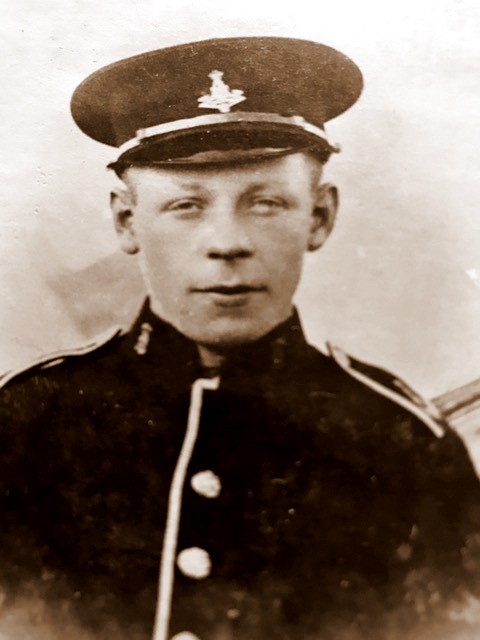
Pte Harold Moody.
[Photograph kindly contributed by his Great Nephew, Peter Green.]
|
26 APRIL. The Battalion spent two days at Camp "A" between Vlamertinghe and Ypres.
"Of the huts we saw little, as they were uninhabitable."
During this time they were shelled intermittently.
"Lt A Beresford-Peirse and 9 other ranks were wounded."
27 APRIL.
1613 Pte Moody Harold. Home at Lingdale N Yorks. Born Eston Yorks and enlisted at Skelton in Cleveland, N Yorks.
Died of wounds, presumably received on the 24th. Aged just 19. He is buried at Longuenesse Military [Hospital] Cemetery, St Omer.
1607 Pte Lawrence Ernest Walker, pictured below with Pte Moody, went to France on the 18th April 1915 and took part in this fighting.
He had been born born in Q1 1893 in Guisborough, N Yorks. He was discharged on 16th March 1917, presumably due to wounds.
But another entry shows him still serving 23 July 1920. He died in June 1971 (in the Don Valley, Yorkshire West Riding).
28 APRIL. The Battalion was ordered to relieve the 5th Yorks Bn in trenches on the Northern side of the Fortuin
to Passchendaele road.
They had a rough time getting forward and did not get there until the 30th.
2 Companies were attached to the Kings Somerset Light Infantry and the other 2 to the London Rifle Brigade.
The march to the trenches is described as going through hell on earth, by now strewn with dead animals and bits of
everything recognisable in the way of equipment.
They had to pass through the village of St Jean which was "utterly
destroyed and slightly more objectionable than Ypres; church gutted, graveyard shelled and a heap of coffins and
battered headstones."
The trenches had been quickly made and provided poor protection - "very bad, narrow, with
scarcely any traverses, nothing at all behind and only funk holes for shelter".
5 days of fighting with many losses followed.
|
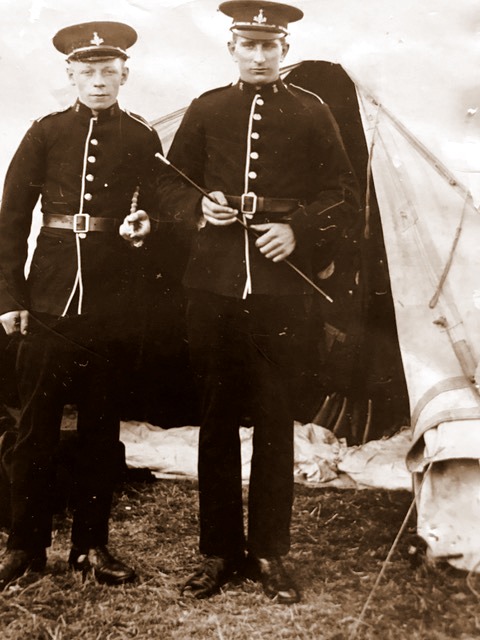
Pte Harold Moody, Left and Lawrence Ernest Walker.
[Photograph kindly contributed by Harold's Great Nephew, Peter Green.
]
|
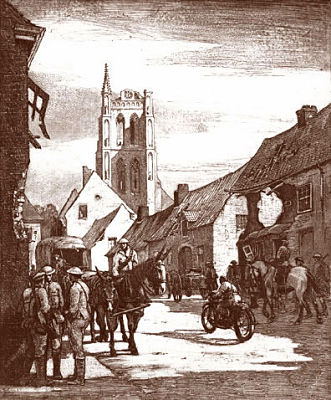
The Road to Ypres through
Vlamertinghe, 1915.
Etching by Canadian Lieut C H Barraud.
|
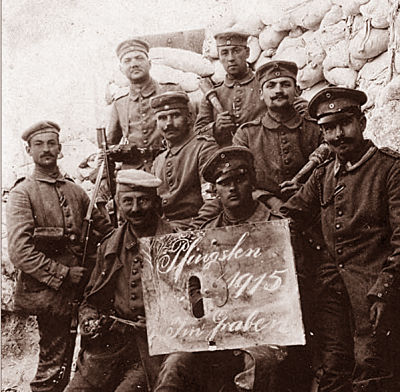
German Infantry. Men of Regiment No 236 at St Julien.
With hand grenades, stick grenades, Mauser rifle with fixed bayonet.
|
The then Chief of Staff of the British Army, Sir John French, had realised that following the German gains of the 22nd
April the situation of troops in the Ypres Salient was perilous.
While Battalions such as the 4th Yorks were holding the Germans, others were furiously digging a new line of trenches to which all would
fall back on May the 3rd.
North East Gazette, 28th:- "LOCAL TERRITORIALS WOUNDED.
News has been received at Skelton, N Yorks that five members of the local detachment F Peggs, S Shaw, J Thornton, J Smith and
J Holden have been wounded.
It is understood that some of them have already arrived in this country. All the men reside in Old Skelton with the
exception of Holden, who lives at North Skelton. Thornton is particularly well known, as he is the drummer in the
Battalion band, and Peggs is a butcher employed by the Skelton Co-op Society.
The others are miners. So far as is known their injuries are not very serious. Postcards have been received indicating that several
Guisborough Territorials have also been wounded."
29 APRIL.
2884 Pte Hicks William Arthur. Home at - 29 Tees St, East Loftus, N Yorks, place of enlistment. Killed in action.
Age 29. Menin Gate Memorial Ypres. "A" Company.
1740 Pte Robinson John Robert. Born at Redcar and enlisted at Yarm N Yorks. Killed in action.
Age 25. Menin Gate Memorial Ypres.
|
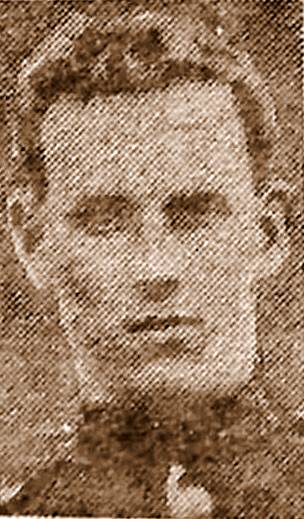
Pte Edward Rust.
|
1238 Drummer Rogers John William. Born and enlisted at Middlesbrough, N Yorks. Died of wounds.
Boulogne [Hospital] Eastern Cemetery.

30 APRIL.
1830 Pte Rust Edward. Home at The Vicarage, Hamsteels, Co Durham. Born at Gateshead on Tyne. Enlisted at Catterick,
N Yorks. Died of wounds. Age 19. Buried at Hazebrouck Communal Cemetery, Casualty clearing cemetery,
56k South East of Ypres.
1270 Pte Wilson John. Home at 4 Stapylton St, Grangetown, Middlesbrough. Born Eston. Enlisted Normanby.
Killed in action. Age 22.
|
[He served under the surname Wilson, but his real name was Betteridge.]
Commemorated on the Menin Gate Memorial, Ypres.
1 MAY.
The following 6 men gave their lives this day and are remembered on the Menin Gate Memorial:-
1915 Pte Easom John. Home at 31 Wood St, Grangetown, N Yorks. Born and enlisted at Eston, N Yorks.
Killed in action. Age 27.
|

Pte Frank Jarvis.
|
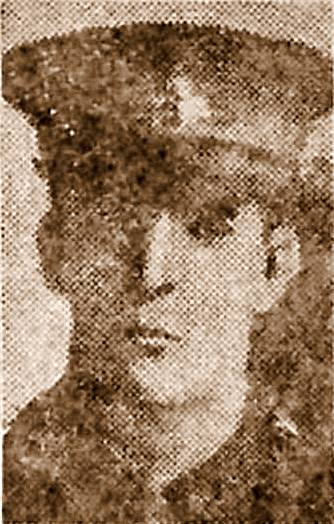
Pte Raymond G Smith.
|
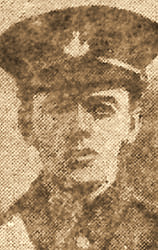
LCpl James J Wanless.
|
394 Pte Jarvis Frank. Home at - 33 Gladstone St, Eston, N Yorks, place of birth and enlistment. Killed in action.
Age 29.
2407 Pte Peterson Harold. Home at Sunderland, Co Durham, place of birth. Enlisted at Northallerton, N Yorks.
Died of wounds.
1939 Pte Sellers William. Home at Eston N Yorks, place of birth. Enlisted at Normanby, N Yorks. Killed in action.
1667 Pte Smith Raymond George. Born at Boosbeck, N Yorks and enlisted at Guisborough, N Yorks. Killed in action. 150501 Menin Gate Memorial, Ypres.
575 L/Cpl Wanless James Joseph. Born and enlisted at Eston N Yorks. Killed in action.
|

Shelled Church at St Julien.
|
2 MAY.
From noon until 4pm the Germans kept up a constant hail of shells.
Then once again they released chlorine gas. It was now less of a
surprise and the troops had improvised respirators "made of cotton-wool, handkerchiefs, mufflers and even towels soaked in soda or whatever
moisture was available."
The line held and frustrated all German attempts to take advantage of the gas.
A Sergeant, Wilf Parker, of the 4th Yorkshires, wrote to his friend in Northallerton:-
"...The worst day we had was Sunday, when the Germans started to advance.
At about 4.30 their artillery commenced to shell us and they didn't half send the shells flying.
Then the Germans came out of their trenches and we let them have it.
We kept firing away but then they sent their gas shells among us.
Oh dear! the smell is fearful.
The poor fellows in the thick of it are absolutely helpless
It gives one a horrible feeling and one hardly knows what he is doing.
Just at this stage George Chapman got killed..."
By 8pm all was quiet again.
|

Sir John French was
Chief of Staff of the British Army from the start of the War in August 1914.
In December 1915, he was replaced by Sir Douglas Haig.
|
The Battalion War Diary states that during this period 6 officers were wounded and one gassed.
34 other ranks were killed and 74 wounded.
The Diary makes special mention of Major H.L. De Legh for his gallantry in getting 15 wounded men out of a burning cellar
which had been set on fire by the enemy's Artillery.
Report in local paper:-
Those immediately behind the fighting line attending to wounded have more than their share of excitement. It is no unusual thing for the stretcher bearers to be under severe shell fire.
Deeds are performed daily which are worthy of distinctions, yet thos responsible for these are the last to make them known or claim credit.
There has just come through news of a particularly meritorious achievement by those whose place is just behind the line temporarily repairing damage in hot conflicts.
A farmhouse used as a resting place for wounded, pending the arrival of the motor ambulances, was the object of a terrific fire.
Scores of shells, as well as some incendiary bombs were directed at it, with the inevitable result that the house was soon in flames.
The farmstead was burning furiously. Beneath in a cellar were over a dozen serious cases of wounded, some of them officers.
There was no time to be lost. A few minutes delay would have meant the suffocation, if not the actual roasting to death of these injured and helpless soldiers.
There was no house near to which they could be taken and their removal from the farm could only be undertaken by the ambulance section at grave personal risk.
With not a moment's hesitation the 5 stretcher bearers and the doctor in charge descended to the cellar. So close were they to the flames that their hair was singed.
|
After a few minutes work all the wounded who were alive were rescued. One soldier collapsed and died in the arms of the doctor as he was being carried out.
The wounded had to be left on the ground a short distance away. There they remained exposed to the dropping shells.
One fell in the midst of them, but by the greatest good fortune all the cases escaped with further injuries.
Sgt A Pallister wrote home:-
If Major De Legh's friends could only have seen him they would have been proud. He had a dressing station about two miles from the trench, but not half far enough.
After dressing hundreds of wounded in four days, he found his place shelled by the Germans. The Doctor sent for an ambulance wagon to get the wounded away and when it arrived the enemy turned their guns on it - the cowards.
Then they fired petrol shells into the farmhouse and set it on fire.
It was then the Major distinguished himself. He worked like a lion and never flinched, although shrapnel and maxim bullets were showering round him. He got all the men out through a small window just in time, for the house collapsed
immediately afterwards.
He set them in a row a few yards from the burning house and the Germans dropped another shell among them. One poor fellow died from the shock. The others were with great difficulty and risk got away.
|

|
Major de Legh would have been about 47 years of age at this time.
He was born in Simonstown Capetown South Africa in 1868 the son of Henry a general practitioner and Catherine Emma de Legh.
He had been Commissioned, as Surgeon-Lieutenant into the 1st Volunteer Battalion, the Princess of Wales's Own (Yorkshire Regiment) on the 11th November, 1896.
Promoted to Surgeon Captain on the 14th April 1897.
Appointed to the 4th Yorks Battalion on the 1st April 1908.
Promoted to Surgeon Major on the 24th November 1908.
He can be found on the 1911 census aged 43 residing with his wife Minnie de Legh and children at 38 Newcome Terrace Coatham Redcar his occupation given as a
doctor of medicine.
He was wounded during these events at Ypres and invalided out.
His wife Minnie died in 1917.
Promoted to Lieutenant-Colonel 1st Sept. 1918, with precedence from 1st June 1916.
He was awarded the Territorial Decoration on the 27th February 1919.
He re-married to Violet Elizabeth (Betty) Collinson on 19th October 1919.
|
Lt.-Col. H. L. de Legh, M.D., T.D., resigns his comn., 30th Mar. 1921, and retains the rank of Lt.-Col., with permission to wear the prescribed uniform.
He died in Durham aged 64 in 1932.
The British Medical Journal for 14th May 1932 had the following obituary:-
We have to announce the death on 11th April of Dr Harry Legh de Legh. The son of a naval surgeon, he was born at Capetown in 1867.
After studying at the Bedford General Infirmary for a year, he went in 1885, to St Bartholomew's Hospital, whence he took his MRCS. LRCP. He obtained the MD degree of
Durham in 1907.
After acting as assistant at Hetton, he practised at Redcar, N Yorks for over 20 years.
In 1915 he accompanied the 4th Yorkshire Battalion to France, and their first engagement at Ypres distinguished himself by gallant conduct in saving 15 wounded men from a
burning farmhouse cellar.
His name is believed to have been thrice sent up for the V.C.
After being severely wounded and invalided home, he was soon appointed S.M.O, No 2 Section Tyneside Garrison with HQ at Tynemouth.
After the War he took up appointments with variious collieries in Durham and Yorkshire as compensation doctor, where he gained the confidence and esteem of both the
companies and the miners.
He was a keen sportsman, and expert on bird culture and a prominent Freemason.
Ptes Wallace, Woodrow, Readman and Signaller L Ward, all belonging to the 4th Yorks, from the Carlin How and Skinningrove district are suffering from wounds and gas fumes received during the engagement in which the Territorials recently took part.
Further casualties are reported in the ranks of the 4th Yorks. Private A Brigham, son of Mr and Mrs Brigham of 15 Talbot St, Middlesbrough has been killed. Private Frank Brown, son of Mr and Mrs A Brown of 3 Apsley St, Middlesbrough has been wounded.
Lieut Edward Williams, 4th Yorks, son of Major Penry Williams MP, who was gassed during the recent fighting, has been brought home to England and is now in hospital in Oxford.
|
|



